A child’s view of the world is influenced by the school they attend. At the same time, children shape the school as an institution with their very own view of things and their childlike forms of expression. In drawings, essays, poems and other sources, they convey their special perspective. This exhibition aims to illuminate the children’s worlds of the former Jewish schools in Hamburg. Schools are places where identities are constantly being renegotiated. The Jewish schools therefore also tell the story of Hamburg Jews’ search for a place in the city’s society. Jewish schools have also always been places of community where friendships were made, where people learned, argued and laughed together. During the time of National Socialist persecution, Jewish schools therefore played an important role as the last points of reference for Jewish children in a city that increasingly excluded them and had them deported in the end. Finally, the Talmud-Tora-Schule [Talmud-Torah School], the Israelitische Töchterschule [Israelite Girls’ School], the Loewenberg-Schule [Loewenberg School] and the smaller Jewish schools are also important points of reference in the urban landscape of remembrance today.
This online exhibition aims to open up new perspectives on the history of the Jewish school system in Hamburg. One focus is on children’s perceptions, therefore the emphasis is on so-called “ego documents” by schoolchildren. Another focus lies on photographs from school life, which in turn follow a special aesthetic. The exhibition shows rarely seen treasures from two Hamburg collections: Ursula Randt’s image archive at the Institute for the History of the German Jews and the archive of the Israelitische Töchterschule Memorial and Educational Center.
The exhibition texts were written by Anna von Villiez, Aline Philippen and Tamara Loewenstein; the exhibition was technically realized by Daniel Burckhardt and conceived by Anna von Villiez, Sonja Dickow and Anna Menny.
While the eighteenth century was still completely marked by traditional religious education, in the nineteenth century old certainties changed in the course of a comprehensive redefinition of Judaism as part of the Christian middle-class majority society. With the long-awaited and finally achieved legal emancipation of the Jews and in the aftermath of the Enlightenment, which brought about a strong turn towards secularism that saw religion fading to the background, the educational requirements for Jewish children also changed.
Non-Jewish schools opened their doors to Jewish students only hesitantly. Although Jewish boys had been able to attend the Johanneum in Hamburg since 1802, equal treatment was not finally achieved until 1861, the year of legal emancipation. When the "Gesetz betreffend das Unterrichtswesen" [Law on Schools and Education] was passed in 1870, Hamburg became the last German state to introduce compulsory schooling. Jewish schools were now increasingly affected by the general development towards public education. At the end of the Weimar Republic, about half of all Jewish school-age children attended state schools.
The Talmud-Tora-Schule [Talmud-Torah School] was founded in 1805 as the Israelitische Armenschule der Talmud Tora [Talmud Torah Israelite Charity School], an Orthodox religious school for boys in Hamburg’s Neustadt district. Under the leadership of Rabbi Isaak Bernays, the school developed into a primary school in 1822. In addition to religious instruction and Hebrew studies, other subjects such as German, history and natural history were part of the curriculum. In 1870, the school received state recognition as a “Höhere Bürgerschule” [secondary school].
As part of a shift of the center of Jewish life from the Neustadt to the Grindelviertel in 1911, the school moved into a spacious new building at Grindelhof 30, in the immediate vicinity of the Bornplatzsynagoge, inaugurated in 1906.
Opened in 1884, the Israelitische Töchterschule [Israelite Girls’ School] at Carolinenstrasse 35, run by the German-Israelite Congregation, was created by merging two charity schools, the privately funded Stiftungsschule [Foundation school] established in 1798 and the Mädchen-Armenschule der Deutsch-Israelitischen Gemeinde [Charity School for Girls run by the German-Israelite Congregation] established in 1818. Over the decades, the charity school originally funded by Hamburg entrepreneur Marcus Nordheim developed into a primary and secondary school where Jewish girls from all walks of life were able to obtain various degrees.
In 1939, the National Socialists merged the girls’ school with the Talmud-Tora-Schule [Talmud-Torah School], which also still existed. From April until September 1939 classes were held in the Grindelhof school building; after the Talmud-Torah School was evicted from its premises, it first moved into the building of the former girls’ school in today’s Karolinenstraße. When this building, too, was claimed by the National Socialists in 1942, classes continued in the facilities of a former orphanage on Papendamm until all Jewish schools were forcibly closed on June 30, 1942.
The Israelitische Höhere Mädchenschule [Israelite Secondary School for Girls], established by Rabbi Markus Hirsch, was opened at Grindelhof in 1893 and moved to Bieberstraße 4 six years after its foundation. The Orthodox private school was attended almost exclusively by girls from wealthy families who were able to pay the expensive school fees required to maintain the private school. Jewish religious instruction and Hebrew language classes were central components of the curriculum of the school, which was recognized as a secondary school in 1912. Like the Loewenberg-Schule [Loewenberg School], the girls' school had to close in 1931 for financial reasons.
In 1863 the physician Moritz Katzenstein founded a liberal Jewish private school for girls located at Johnsallee 33. 29 years later, in 1892, the writer and pedagogue Jacob Loewenberg took over the school. After his death in February 1929 his son, the pedagogue Ernst Loewenberg, took over the management. The school, which was also open to Christian girls, was recognized by the state as a secondary school in 1912 and was based on the ideas of the art education movement. This reform pedagogical movement, decisively influenced by Alfred Lichtwark, pedagogue and director of the Hamburger Kunsthalle [Hamburg Art Museum] from 1886 to 1914, focused on the teaching of musical-aesthetic subjects, such as music or art, and the inclusion of physical activities, for example as part of musical or theater performances. In addition to collaborations with Lichtwark, many other important pedagogues and artists worked at the school, such as the poet Otto Ernst and the writer Heinrich Scharrelmann. As a result of the world economic crisis, the school had to close in 1931 due to financial difficulties.
Until the early nineteenth century, the upbringing and education of Jewish children unfolded exclusively within their respective congregation or family and was correspondingly religiously oriented. In the course of the Enlightenment and Jewish emancipation, parents with a liberal attitude in particular sent their children to new Jewish educational institutions which had emerged over time and which included secular subjects in their curriculum, to so-called Jewish-Christian “simultaneous schools”, which accepted both Jewish and Christian children, or to the state schools established subsequently. This was meant to promote the integration of the children into their non-Jewish environment. At the same time, some formerly Jewish private schools developed into public schools, which were also very popular with Christian families because of their high standards. Examples were the Anton Rée Realschule [secondary school] in Neustadt and the girls’ school run by Ria Wirth.
The photos were taken at the Breitenfelder Schule, a municipal primary school. About half of the pupils were Jewish before 1933, and girls and boys were taught together, which was very unusual at the time.
In the course of the Enlightenment and Jewish Emancipation towards the end of the eighteenth century the focus shifted from a traditional religious education to a secular education for both sexes. Up until then, girls had mostly been educated in their parental homes and exclusively in areas that were intended to prepare them for their future role as wives and mothers. Around the turn of the century, both public and private educational institutions, financed by Jewish communities or by Christian and Jewish private individuals, were established to instruct daughters from families with different religious beliefs and financial backgrounds in languages and general subjects. But whether state-funded or private, Jewish or non-Jewish – until the 1890s there was no possibility for girls to graduate from high school and take the university entrance exam. Attending a seminar for female teachers, followed by work as a teacher and so-called “teacher celibacy” was the only way for young women to continue their education. Only the vehement demands for a reform of the education system by the women’s movement and the subsequent Prussian girls’ school conferences in the years 1906 to 1908 paved the way for the establishment of girls’ grammar schools and the admission of women to universities.
Jewish schoolchildren had several roots: The Hamburg environment with its special North German-Hanseatic character and their Jewish religion. This meant they grew up as typical Hamburg boys and girls whose childhoods were also marked by Jewish festivals, synagogue visits and family traditions. These different facets of childhood identities can be discovered in sources of different kinds. While it seemed possible for these points of identification to coexist up until the Weimar era, the National Socialist agenda radically reduced Jewish children to an alleged “otherness.”
The childhood and youth of girls and boys took place largely separately. Co-educational schools were still very rare until 1933 and were considered experimental; Jewish schools remained strictly separated by gender.
The “Schultüte” - a large cornet of cardboard filled with sweets and little presents given to children on their first day at school - is a German tradition. Since the nineteenth century, the custom of the so-called “sugar cone” or “school cone” has spread from Thuringia and Saxony across the German-speaking countries and has always sweetened the first school day of both Jewish and non-Jewish children. At the same time, giving sweets at the beginning of school has a long tradition of its own in Judaism. For example, when children entered the Cheder, a Torah school for boys in Western European Judaism that was customary until the eighteenth century, the teacher gave baked sweets to his five-year-old students as gifts.

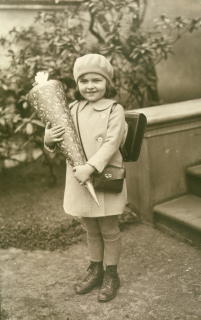
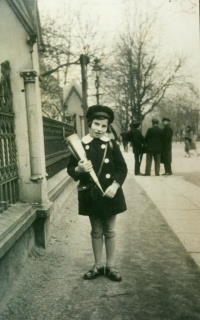
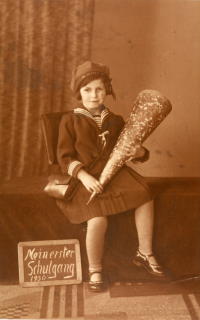
When the “Law on Education” was passed in November 1870, which established the state education system in Hamburg, all Jewish schools had to orient themselves on a state-prescribed curriculum. Jewish elements could, however, be preserved by celebrating traditional Jewish holidays, by Jewish religious instruction and by teaching the Hebrew language.
These pages are excerpts from the Hebrew primer “Licht und Freude” [Light and Joy], which was co-designed and published in the first third of the twentieth century by Hugo Mandelbaum (1901–1997), among others. From 1923 until his emigration to England in 1939, he worked as a teacher at the Talmud-Torah School. In 1940 he emigrated to the USA and from there to Israel in 1971, where he died in Jerusalem in 1997.
In addition to traditional Jewish celebrations such as the Passover, Yom Kippur and Sukkot holidays, patriotic holidays such as the Emperor’s birthday were also celebrated. Students and teachers of the Talmud-Torah School were among the volunteers in the First World War. After 1933, Jews were often denigrated as not “patriotic”. In May, high school student Karl Zimmermann wrote to his friend Kurt Brimer: “We celebrated the 1st of May duly here. Should this letter be opened, the censor may be proud to learn that the T.T. [Talmud-Torah School] does not leave anything to be desired with regard to national sentiment.”
Many pictures of school trips survived. They show typical excursion destinations as they are still visited by many school classes from Hamburg today: the port of Hamburg, the Lüneburg Heath, and the city of Lübeck. The pictures express the relaxed atmosphere, which was in contrast to the often very strict instruction. Also, the gender separation customary in schooling was loosened during the excursions. From the end of the 1930s onwards, prohibitions for the Jewish population made excursions increasingly difficult and eventually impossible.
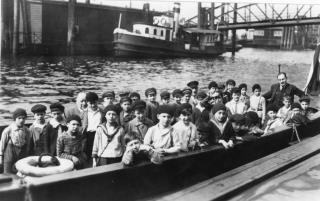
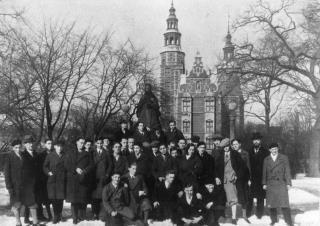

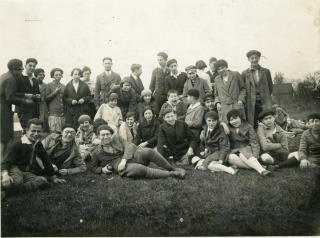
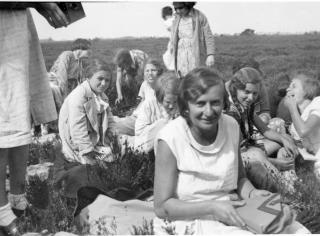

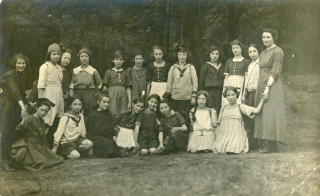
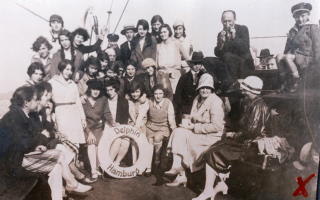
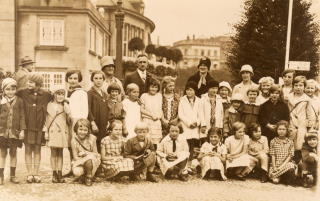


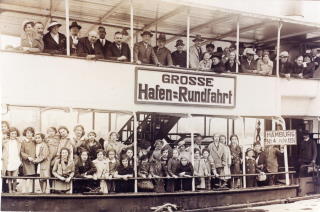
The non-Jewish school on Alsenstraße was founded in 1908 as a primary school. The dual schoolhouse taught girls and boys from first to seventh grade separately and had two headmasters and separate teaching staff. The Jewish teacher Edith Behrend, born in 1880 and deported to Minsk on November 18, 1941, worked at the school on Alsenstraße 21. She taught girls from the first to the sixth grade in various subjects such as gymnastics and local history. Striving for a Jewish-Christian dialogue and the realization of the reform pedagogical approaches of the time, her class maintained a class partnership with the students of Lilli Traumann’s, teacher at the Israelitische Töchterschule [Israelite Girls’ School] and a colleague of her sister, Elsa Behrend. The girls went on excursions together, held celebrations, wrote letters and exchanged fish species for the aquariums in their respective classrooms.
Class photos are fascinating because they are such a familiar standard format from one’s own school days that also provides an undistorted glance at children in their school environment. As historical sources, they allow for many different approaches. For example, they are important memorabilia for the survivors as well as windows into the history of an individual school. Here we present them as two series in order to direct the viewer’s attention to the different gender images. It was not until the 1950s that coeducation gained acceptance in Germany. Until then, the worlds of boys and girls were largely separate, at least in schools.
Important scholars and pedagogues, such as the writer Jakob Loewenberg, worked at Jewish schools. The sources, however, not only tell of the well-known school principals, but also of caretakers and cleaners, who were also important protagonists in the school community. Gender also had a decisive influence on the reality of life of those employed at Jewish schools. Girls were denied access to secondary schools, grammar schools and universities in the nineteenth century, and the focus of their government-prescribed short educational path was still on the education of housewives and wives until the turn of the century. Only the seminars for female teachers, which were established in the first half of the nineteenth century, made higher education and financial independence possible. Yet for women, the profession of teacher was also tied to the so-called “teacher celibacy,” which legally stipulated the incompatibility of marriage and employment for female teachers until the middle of the twentieth century.
Alberto Jonas (1889–1942) taught Hebrew, Greek and Latin at the Talmud-Tora-Schule [Talmud-Torah School] from 1922 to 1924 before being appointed Director of the Israelitische Töchterschule [Israelite Girls’ School] in 1924. During his term of office, the school, established in 1798 as a charity school for girls, was improved in terms of organization and education to meet the demands of modern girls’ education. In 1930 the Israelitische Töchterschule was recognized by the state as a primary and secondary school. After the National Socialists combined the Israelitische Töchterschule and the Talmud-Tora-Schule in 1939 in the premises of the girls’ school, renaming it “Volks- und Höhere Schule für Juden” [primary and secondary school for Jews], Jonas was appointed its director in 1940. Together with his colleagues he tried to preserve this last existing Jewish school for the remaining children as a place of safety with as undisturbed a school day as possible. On July 19, 1942 Jonas was deported together with his wife, school medical officer Marie Anna Jonas, and their daughter Esther to Theresienstadt, where he died only a few weeks later, on August 29.
Arthur Spier (1898–1985) was appointed director of the Talmud-Tora-Schule [Talmud-Torah School] in 1926. At only 28, he succeeded rabbi and educator Joseph Carlebach, who had reformed the Orthodox boys’ school in the 1920s, introduced new teaching methods, emphasized sports and the arts more strongly, and organized excursions and school trips. As was the case under Carlebach, the pedagogical concept of Spier, who grew up in a strictly Jewish Orthodox family, focused on a combination of secular education and Jewish upbringing in order to strengthen the Jewish identities of his students. Under his leadership, the school became a Jewish comprehensive school with primary school, elementary school and secondary school. After the National Socialists came to power in 1933, he also established a Jewish school center in Hamburg whose trade and agricultural training programs were intended to prepare students for emigration to Palestine. As a result of the November pogrom of 1938, in the course of which the Talmud-Tora-Schule teaching staff were imprisoned and Spier himself mistreated, he organized and accompanied several “children’s transports” to England and other European countries. After emigrating to the USA in 1940, he settled in New York, where he founded the Manhattan Day School, which was structured similarly to the Talmud-Tora-Schule. He headed this school as well as the religious school of the city’s Spanish-Portuguese Synagogue.
A well-known writer, Jakob Loewenberg (1856–1929) published poetry, children’s literature and educational writings. After spending time in London, Paris, Marburg and Heidelberg, he moved to Hamburg in 1886 and in 1892 became director and owner of the private girls’ secondary school founded by Moritz Katzenstein. A reform pedagogue, he ran the school, which was open to girls of all denominations, according to the ideas of the art education movement. These included in particular the emphasis on art, literature and music lessons and close cooperation between students and the Hamburger Kunsthalle [Hamburg Art Museum] and its director, Alfred Lichtwark. In addition to his work as a writer and teacher, Loewenberg was involved in a variety of activities, for example in the Literary Society, the Teachers’ Association for the Promotion of Art Education, the Teachers’ Council and the Teachers’ Chamber. After his death, his son Ernst Loewenberg took over the school, which had to close only two years later, in 1931, due to the world economic crisis. Today a plaque mounted on the building at Johnsallee 33 commemorates its history.
Mary Marcus (1844–1930) was head of a privately funded school for Jewish girls from poor families founded in 1798. She held this position from 1868 to 1884. After the merger of this school with the Mädchen-Armenschule der Deutsch-Israelitischen Gemeinde [Girls’ Charity School of the German-Israelite Congregation] in 1884, she served until 1924 as director of the resulting Israelitische Töchterschule [Israelite Girls’ School]. Throughout her career Marcus tried to counteract the financial discrimination of girls by means of a careful upbringing and comprehensive education in order to overcome the class distinctions between girls from different social backgrounds. At times, Marcus was also able to achieve her pedagogical goals against the resistance of the congregation board, which had neglected girls’ education for a long time. Modeled on the curriculum of Hamburg primary schools, she placed a special focus on teaching German, literature and foreign languages, which was meant to contribute to the social recognition of the girls. Marcus died at the age of 86, having retired only six years earlier. All her life, Marcus did not start a family. At the beginning of the twentieth century, the so-called “Lehrerinnenzölibat” [teacher’s celibacy], which stipulated the dismissal of a working woman in the event of marriage, still applied.
Some of the Jewish schools counted renowned pedagogues and intellectuals among their teaching staff who worked far beyond the school. Poet Jakob Loewenberg or teacher and later Hamburg Chief Rabbi Joseph Carlebach are two examples. Among the teachers were many pioneers who belonged to the first and second generations of women teachers. In the period of persecution after 1933, many of the teachers took their role as important attachment figures in the dissolving lives of the children very seriously. They often corresponded extensively with former students. The school staff also included cleaning and auxiliary staff, caretakers and others who are often overlooked in the history of Jewish schools.
Marie Anna Levinsohn was born on January 12, 1893 in Fischhausen in East Prussia as the daughter of a pharmacist. Orphaned at the age of 15, Marie Anna attended a secondary school for girls with an associated teacher training seminar in Königsberg (Kaliningrad), which she successfully completed in 1911. During the First World War she worked as a nurse for the Red Cross in Königsberg. From 1917 she also prepared herself for her graduation examination, which she passed in 1919. Subsequently she began studying medicine at the Albertus University in Königsberg – still an uncommon opportunity for women at that time. After earning her doctorate in 1922, she received her license to practice medicine in 1923. That same year she married Alberto Jonas, who was a teacher at the Talmud-Tora-Schule [Talmud-Torah School] in Hamburg.
In 1924 her daughter Esther was born and Alberto became director of the Israelitische Töchterschule [Israelite Girls’ School]. Marie Anna worked there as a school doctor until 1932. In the following years she volunteered at the University Hospital Eppendorf as well as at the Israelite Hospital. From 1938 she worked as a nurse and taught biology and health at the Israelitische Töchterschule. At the beginning of 1942, the Jonas family had to leave their flat in Eppendorf on Woldsenweg 5 and move into a room in a so-called “Judenhaus” [House for Jews] at Laufgraben 37. On July 19, 1942 the couple and their daughter were deported to Theresienstadt. Marie Anna was murdered in Auschwitz on October 12, 1944.
Paula Friedländer, who was born in 1900 as Paula von Halle, was a student at the Israelitische Töchterschule [Israelite Girls’ School]. From 1940 to 1942 she worked as a cleaner at the school. She and her husband, Adalbert Friedländer, were deported to Theresienstadt in 1942. Both survived, but many of their relatives were murdered. The family left many documents to the Israelitische Töchterschule Memorial and Education Center, among them Paula’s “identity card”, which identified her as a “Jewess”, as well as a portrait drawing made in Theresienstadt.
A treasure trove of children’s testimonies about Jewish school life has survived: Letters, school essays, drawings, poetry albums and poems. They open up a rare perspective on the history of Hamburg’s Jewry. The surviving sources give accounts of children’s worlds from the German Empire, the Weimar period and of increasing persecution under National Socialism. Here, too, the dual rootedness in the Hanseatic city with its Nordic character and Jewish tradition is clearly evident. Many experiences related here are still part of the school days of a Hamburg child: the Schultüte [a large cornet of cardboard filled with sweets and little presents given to children in Germany on their first day at school], a harbor tour and hikes in the Lüneburg Heath.
This exercise book was filled in the style of a diary in 1930 by Esther Wigderowitsch, a student at the Israelitische Töchterschule [Israelite Girls’ School]. She vividly describes her everyday life as a young girl in Hamburg, where Jewish festivals and visitors from Jerusalem were just as natural as trips to Jenisch Park or tram rides. At this point we do not have any information on her subsequent fate.
This photo, probably taken around 1933, shows Ruth Moses (middle row, second from left) and other students of Lilli Traumann’s class. Some of the girls, such as Edith Hirt (first row, first from left), Marion Heymann (first row, second from right) and Hilde Falck (back row, second from left), compiled an exercise book of couplets for Traumann while in first grade.
The beginning of National Socialist rule in Germany in January 1933 led to a first rift in the biographies of Jewish children and youths. An increasing number of prohibitions restricted their everyday lives, and they were increasingly turned into "second-class children." Their self-image as “Jewish Hamburg locals” began to falter. The decisive biographical break occurred in November 1938 with the pogrom night and the arbitrary arrests and deportations to Sachsenhausen, for it was then that the mass exodus began, driving most Jewish families out of the city and into an uncertain future. Those who could no longer flee almost all became victims of deportations, and the short lives of some 300 Jewish children from Hamburg ended abruptly and cruelly.
A correspondence file from the years 1936 to 1939 from the Israelitische Töchterschule [Israelite Girls’School] gives an idea of the hardships hidden behind the formal letters. The parents often took their children out of school a few days before fleeing Germany so that they could help pack up the household.
Max Brimer was born on October 16, 1914 and was a student at the Talmud-Tora-Schule [Talmud-Torah School]. Before he emigrated to Palestine in 1933, he lived at Goldbekufer 46 in the Hamburg district of Winterhude. He was a member of the Zionist gymnastics and sports club “Bar Kochba,” founded in 1910. As a means of strengthening Jewish identity and a national consciousness, the association was to counter both antisemitic propaganda and the prejudice of the “intellectual and unathletic Jew” by physical fitness.
The Israelitische Töchterschule Memorial and Education Center holds in its collection a large number of documents and winner’s certificates won by Brimer that testify to his sporting commitment and success. For example, he held a “leadership certificate” which authorized him to lead excursions for the club, and in 1932 he took part in the “Jewish Olympic Games Maccabiah.” After his emigration to Palestine, he worked as an editor for army publications and as a translator for German, English and French.
Karl Zimmermann was later able to emigrate himself and lived in Israel. He is the father of the historian Moshe Zimmermann.
Text of the letter (excerpt): “I am glad that Belzig is beautifully situated. So at least you have a chance of enjoying a beautiful summer. For me the prospects are bleak. Never have I stepped into May like this. Not a verse written for several months. That is quite telling […].
At school you miss old faces and you discover new ones. The great exodus continues. Günter and you, you are gone; Edgar is preparing for America; Anni has given up her studies and believes she will be able to go to Erez in half a year. It becomes desolate and empty around me. The people I like are scattered to the four winds. Soon I will have nothing but my memory. Cursed, and one should not become sentimental! — By the way, memory is a good invention. The darker the present, the brighter it is. […]
PS. My favorite pastimes are sleeping and bathing. I am happy – now as never before – that I am a frequent and long sleeper. I go through my bath with that thoroughness with which one carries out a symbolic action. I shed all the dirt of my environment.”
The graduation certificates of Jewish schoolchildren are often the last traces they left in Hamburg. The fate of many of them remains unknown to this day. The certificates issued by the Israelitische Töchterschule [Israelite Girls’ School], which was later merged with the Talmud-Tora-Schule [Talmud-Torah School], often contain references to the children’s future, for example when emigration is cited as the reason for leaving school. In retrospect, the usual farewell phrases used by the school seem cynical when students are dismissed with “best wishes for the future”. The last certificates in this series date from June 30, 1942, a few days before all Jewish schools were closed throughout the Reich and while deportations had already begun. Around 300 Jewish schoolgirls were unable to flee and became victims of the Shoa.
After 1933, more and more children who had previously attended non-Jewish schools came to Jewish schools. The “First Ordinance to the Law against the Overcrowding of German Schools and Universities” [1. Verordnung zum Gesetz gegen die Überfüllung deutscher Schulen und Hochschulen] of April 25, 1933 limited the number of Jewish students allowed at secondary schools and universities to 5%, and to 1.5% for new admissions. The children who had to switch schools often came from families with little or no Jewish orientation and had had little connection with Judaism up to then. Initially the Jewish community shrank slowly, but after the 1938 November pogrom this process accelerated rapidly. Immediately afterwards, on November 15, 1938, Jews were banned outright from attending state schools. After the merger of the Talmud-Tora-Schule [Talmud-Torah School] and the Israelitische Töchterschule [Israelite Girls’ School] in 1938, there was only one Jewish school left in Hamburg where the remaining Jewish children were taught. Thus this school became the last community of Jewish families.
Lilli Traumann (1903–1990) first studied at Jakob Loewenberg’s school and subsequently at the Helene-Lange-Oberrealschule secondary school, from which she graduated in 1923. After training as a teacher, she accepted a position at the Israelitische Töchterschule [Israelite Girls’ School] in 1926, where she mainly taught primary school classes. A convinced Zionist, she decided to emigrate to Palestine at the end of 1933. Her sister, Susi Traumann, who had just finished her pedagogical studies at the University of Hamburg and had now also started teaching at the Israelitische Töchterschule, took over the third grade. In Tel Aviv, Lilli Traumann worked at a school founded in 1934 for children of German immigrants and published Hebrew teaching material. Her popularity with the children is evidenced by the many letters she received from Germany after emigrating.
From 1933 on, Jewish people in Germany increasingly had to part from relatives, friends and acquaintances. Letters were the only way to stay in touch. The Israelitische Töchterschule Memorial and Education Center holds a collection of letters that contain messages by former schoolgirls to their teacher, Lilli Traumann, who emigrated to Palestine in 1933. The lovingly written and illustrated letters of the children focus in particular on the pain of separation from their teacher and the hope of meeting again in Palestine. Unfortunately, we do not have any further biographical background on many of the girls.
Ruth Moses was born in Altona on May 1, 1925. She was a student at the Israelitische Töchterschule [Israelite Girls’ School] and was taught by both Lilli and Susi Traumann, who in 1933 took over the third grade after her sister had emigrated. Ruth’s parents were Iwan and Rifka Becky Moses, née Grünberg. Ruth’s father, a trained bookbinder, worked in various printing works at the beginning of the twentieth century, such as the Konrad Hanf printing works and the Hans Artmann printing works. Ruth’s mother worked as a stenographer for the Russian trade mission until 1941. Although her family had planned to emigrate, they never did for reasons that remain unknown. On November 8, 1941 Ruth and her parents were deported to Minsk.
Hilde Dublon was born on September 10, 1924 in Lüneburg as the daughter of Daniel and Gretchen Dublon. In the 1930s her family moved to Hamburg, where her father worked as a cattle dealer in the Karolinenviertel district and Hilde attended the Israelitische Töchterschule [Israelite Girls’ School] in today’s Karolinenstraße. On July 19, 1942 Hilde was deported to Theresienstadt together with her parents and her aunt Henni Dublon. She died of typhoid fever on May 15, 1943 at the age of 18. Her parents survived the concentration camp. While Gretchen emigrated to the USA after the war, Daniel lived in Hamburg until his death in 1960 and supplied the Jewish community with kosher meat. The Israelitische Töchterschule Memorial and Educational Center keeps a collection of letters, postcards and photos which Hilde had sent from Hamburg to her emigrated schoolmate Ruth Cohen in Palestine after 1933.
In this “poetry album” [Poesiealbum] kept by the Jewish student Irma Heimann, born 1922, many of her family members and friends wrote the sayings and wishes that are still common today. Irma took the album with her when the family emigrated. There are entries in French and later in English. The album documents the relationship network of an adolescent at the beginning of the 1930s. In times of flight, persecution and war, these connections could only be maintained in writing, but often lasted until long after 1945.
Since schools are a formative factor for children’s biographies, the memory of their school days is often important for survivors of the Shoah. For a long time after 1945, only the survivors themselves remembered the former Jewish school life of Hamburg in different ways. In 1954, former teachers of the Loewenberg-Schule [Loewenberg School] met in Israel. It was not until the 1980s that committed Hamburgers began to try to come to terms with this history, and teacher Ursula Randt played a particularly important part in these efforts. Public commemoration of Jewish school life did not take place until 1989, when the Israelitische Töchterschule Memorial and Education Center was established under the auspices of the Volkshochschule (adult education center) Hamburg.
Language teacher and author Ursula Randt (1929–2007) did more research than anyone else on the Jewish school system in Hamburg. Since the end of the 1970s, she has dedicated herself to this subject, mostly on a voluntary basis, making contact with survivors all over the world and courageously campaigning for urban sites of remembrance. Since the early 1970s, she had been working as a speech therapist at Karolinenstraße 35, where a speech therapy school was located after the war. When she heard about the history of the building from survivors, she made it her mission to render the history of Jewish schools visible again. Numerous publications followed, which to this day are standard works on the subject. Her decades of correspondence with former students at Jewish schools have resulted in a valuable collection of documents and photographs, which is now divided into several archives. As a knowledgeable chronicler and good listener, she was also an important person of trust for the survivors. She was awarded an honorary doctorate in 1989 for her academic achievements.
Founded in 1989 under the auspices of the Hamburg Volkshochschule [adult education center], the memorial and education center is now housed in the building of the former Israelitische Töchterschule. In 1998 the listed building was named after Dr. Alberto Jonas, the school’s last principal. The center offers political education programs especially on Jewish history and contemporary life as well as on the history of National Socialism. Language courses in Hebrew and Yiddish also take place here. The upper floor houses the permanent exhibition “Das ehemalige jüdische Schulleben am Grindel” [Former Jewish School Life in the Grindel District].
Kurt Goldschmidt was born on March 30, 1923, in the St. Pauli district of Hamburg to a Jewish father and Christian mother. After completing secondary school in 1938, he became an apprentice at the Jewish-owned import and export company Frankfurter & Liebermann. Shortly thereafter, following the November pogrom of 1938 (“Kristallnacht”), Jewish businesses were “Aryanized” and he lost his position. When the Jewish congregation of Hamburg began offering professional training programs to prepare young Jews to immigrate to England, Goldschmidt elected to become a locksmith. He split his time between academic courses at the Israelitische Töchterschule on Karolinenstraße and a metal workshop on Weidenallee. After less than a year, the workshop was closed by the Gestapo and he and his classmates were sent to produce military parts. In early 1945, Goldschmidt was deported to Theresienstadt where he remained until its liberation by the Red Army on May 9, 1945. He and his wife Sonja were married in 1949 in Hamburg. Following a one-year visit to the United States, they immigrated to New York, where they live today.
In June 2019, Kurt Goldschmidt visited his former school as participant of the Hamburg Senate’s visitor program. During his visit, he shared that one of his fondest memories of his time at the Israelitische Töchterschule was playing table tennis behind the school with his first girlfriend Esther Jonas, daughter of the school’s former director Dr. Alberto Jonas. To this day, after living in the United States for many years, he still considers himself first and foremost a true Hamburger at heart.
Conception: Anna von Villiez, Sonja Dickow und Anna Menny. Texts: Anna von Villiez, Aline Philippen und Tamara Loewenstein. Technical Implementation: Daniel Burckhardt. Translation: Insa Kummer.
As of: June 3, 2020.
